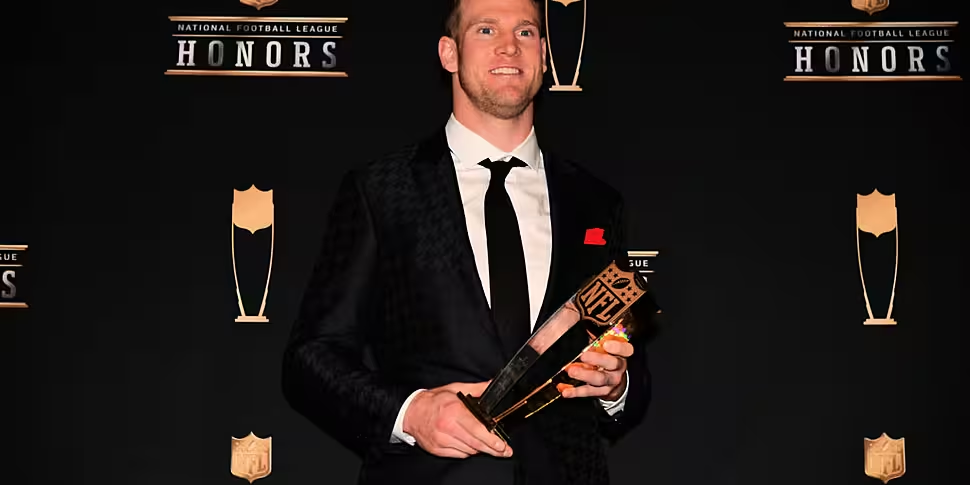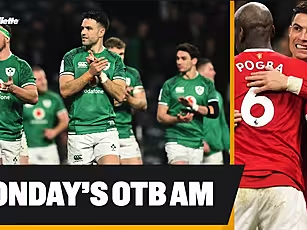Ryan Tannehill played a complementary role during the Tennessee Titans playoff run last season, but he was one of the best quarterbacks in the NFL during the regular season. Now, the Titans are trying to sustain success with him as their starting quarterback in a way the Miami Dolphins couldn't.
Ryan Tannehill started three playoff games last season. He's now the Tennessee Titans long-term starter, earning almost $30 million per year.
12 months ago, Tannehill took a pay cut to go to Tennessee. The Miami Dolphins were tanking to get a franchise quarterback, so they gave Tannehill away for a late-round pick swap. But it wasn't just that. The Titans wouldn't pay his full salary, so Tannehill had to take a pay cut and the Dolphins had to agree to pay $5 million of his salary. Tannehill was clinging to his spot in the league as a backup.
The Dolphins paid Tannehill to start in the playoffs for the first time with another team. The Titans are now paying him to be their starter for at least the next two seasons. A two-year commitment, Tannehill can be released without much penalty from 2022 onward, is not a big risk. It's not a real long-term commitment in the NFL. But even if the Titans did commit to Tannehill for a longer spell, the risk isn't significant.
Despite winding up as a backup last offseason, Tannehill has been a consistently good quarterback throughout his career. His final season in Miami was plagued by a shoulder injury and the lingering effects of his return from his torn ACL. His deep ball disappeared and his effectiveness took a notable hit. Prior to tearing his ACL, Tannehill was consistently one of the better starting quarterbacks in the NFL.
He just happened to play for one of the worst-run franchises in the league. The Dolphins had a conveyer belt of dysfunctional offensive linemen and wide receivers go through Miami during his time there.
For most of his career, Tannehill existed in situations that made success unsustainable. He would be pressured at the top of his drop with no receiver open downfield. Despite this, he regularly charted as one of the most accurate quarterbacks in the league. During his peak years prior to his ACL tear he was one of the best deep passers in the NFL. He also excelled at throwing the ball from outside the pocket or against pressure within the pocket. Tannehill took a lot of sacks because they were unavoidable sacks. His receivers dropped a lot of passes, so his raw stats never accurately reflected his performances.
With the Titans last year, Tannehill's accuracy was his strongest trait.
![]()
His deep ball was only league average, but part of that was the limitations of his receivers getting open downfield. It wasn't until later in the season when Khalif Raymond became a part of the offence that Tannehill had a consistent deep option. His average deep ball was the only thing preventing Tannehill from being the most accurate passer in the NFL. No other quarterback hit short throws as often as he did and only Matt Ryan was more accurate in the intermediate range. Ryan was 0.1% more accurate than him.
Tannehill had the third-best interceptable pass rate at 2.3% despite being the third-most aggressive decision-maker in the league. Tannehill threw to the first down line on 48% of his attempts, Matthew Stafford led the league at 51.5%.
Everything about Tannehill's performances last season suggests that his success wasn't a fluke.
Like any sport, the NFL is susceptible to one-hit wonders. The NFL is actually more susceptible because of how short the season is. Quarterbacks are heavily judged on TD-INT ratio and wins-losses. Josh McCown can fluke his way to a 13-1 touchdown-to-interception ratio. Blake Bortles can find himself in the AFC Championship Game. Case Keenum can find himself in the NFC Championship Game the same year. Nick Foles won the Super Bowl that year.
Get hot at the right time or find yourself in a great supporting cast with some luck and you can make a lot of money in the NFL. That's not who Ryan Tannehill is though. He's been very unlucky for most of his career. In truth, his luck likely isn't changing much moving forward.
Tannehill's success probably isn't sustainable. Arthur Smith's offence isn't that far a departure from Mike Mularkey's offence that preceded it. Schematically, it's run-oriented. It doesn't scheme open receivers or create easy offence for the quarterback. Marcus Mariota played very well for most of his career in Tennessee. But he was worn down. The expectation to make high-end plays at a much higher rate than his peers made it impossible to sustain success.
Efficiency is what wins in the NFL. You can't be like Jameis Winston, racking up touchdowns and yards while making mistake after mistake. Andy Reid and Kyle Shanahan create easy plays for their quarterbacks so they can be efficient. That's how you consistently win with different quarterbacks.
Basically, Arthur Smith asks his quarterbacks to write a thesis on nuclear fusion while expecting them to keep up with quarterbacks doing basic arithmetic.
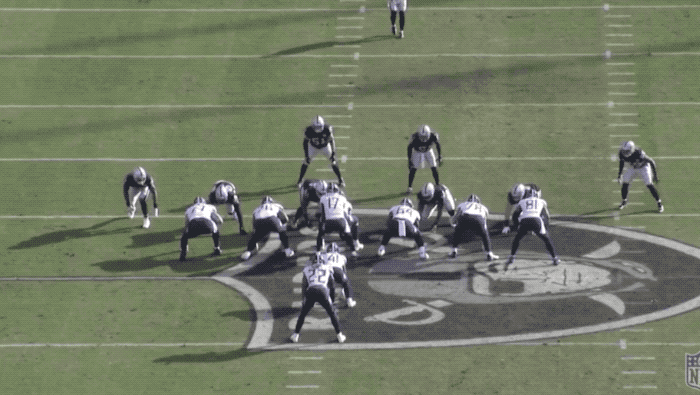
Tannehill lined up under centre for 31.2% of his pass attempts last season, the fourth-highest rate in the NFL. He used play-action on 25.7% of his pass attempts, the eighth-highest rate in the NFL. Derrick Henry is the focal point of the Titans offence, not the quarterback. The quarterback is expected to work off of play designs that accommodate the running back first.
The above play is typical of the Titans passing game. Tannehill lines up under centre before executing a play fake, taking his eyes away from the defence. The receivers are running slow-developing routes. That means they are running vertically downfield, not looking back for the ball early in the play.
Neither of his crossing routes is open in the middle of the field, which forces Tannehill to throw to his fullback running deep down the sideline.
Khari Blasingame isn't Kyle Jusczyzk and he doesn't have Kyle Shanahan scheming him open. Blasingame is in a straight sprint against Bruce Irvin. He gets a small amount of space outside, but he can't get upfield to space. There is a tiny window for Tannehill to throw into. This is a low-percentage throw that Tannehill makes work. It's a typical throw for him from last season.
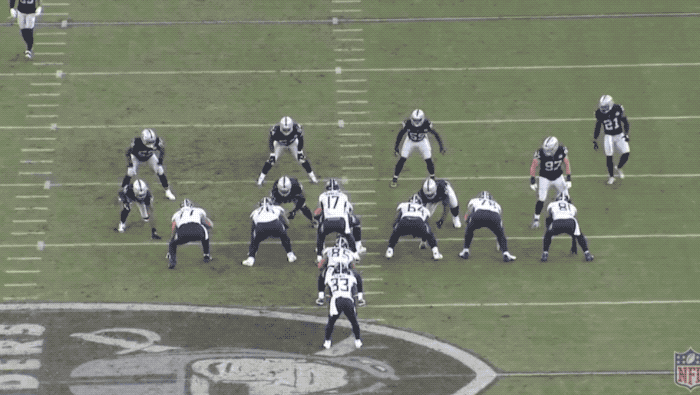
This is a similar play from the fourth quarter of the same game. This gif freezes at the point the third receiver comes into the screen downfield. AJ Brown and Corey Davis both ran slants from the wide side fo the field, while the fullback acts as the drag route beneath them. The spacing and timing of this play are broken. Every team uses play-action, but play-action designs are all very different from each other.
Kyle Shanahan carried Jimmy Garoppolo to the Super Bowl last year with outstanding play designs.
Shanahan's plays always look similar to the play-action plays of other teams, but the specific details separate him. On this play, the play-action movement in the backfield isn't timed with the receivers' routes. The offensive line also isn't selling the play fake. Linebackers read the movement of offensive linemen to determine where they go at the beginning of each play. When the linemen don't sell the play fake, the linebackers drop back into coverage quicker.
That's what happens here. Tannehill ultimately has to heave the ball back across the field in hope rather than expectation.
Tannehill was so good last year he made many plays that looked like that one work.

This image comes from the Week 16 game against the New Orleans Saints. Tannehill has executed a bootleg play fake and has reached the point of the play when he should be throwing the ball. He's in the green circle. Four of Tannehill's five eligible receivers are covering each other in the red circle. Tajae Sharpe is circled in blue, he's running a slant on the back-end that is comfortably covered.
Tannehill turns this play into a touchdown.
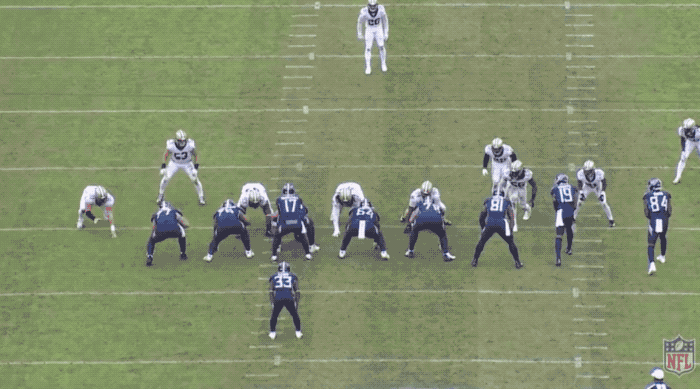
On a play where nothing works, the Titans score a 36-yard touchdown. Tannehill deserves all the credit for extending the play then having the awareness to locate Tajae Sharpe. It's a high-end, difficult play for a quarterback to execute. Tannehill made it work. NFL teams regularly conflate a quarterback covering for his coach with good coaching.
Arthur Smith's offence scored on this play, but the coordinator only deserves criticism for it. The process didn't match the result.
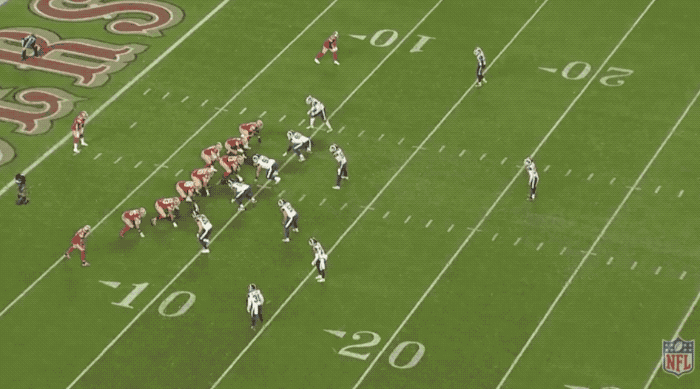
Here is a typical Shanahan play fake. The left side of the offensive line aggressively blocks outside, encouraging the linebackers to come forward. The play fake is quicker so the quarterback turns to survey the defence quicker. And the pre-snap motion encourages the underneath coverage to come forward.
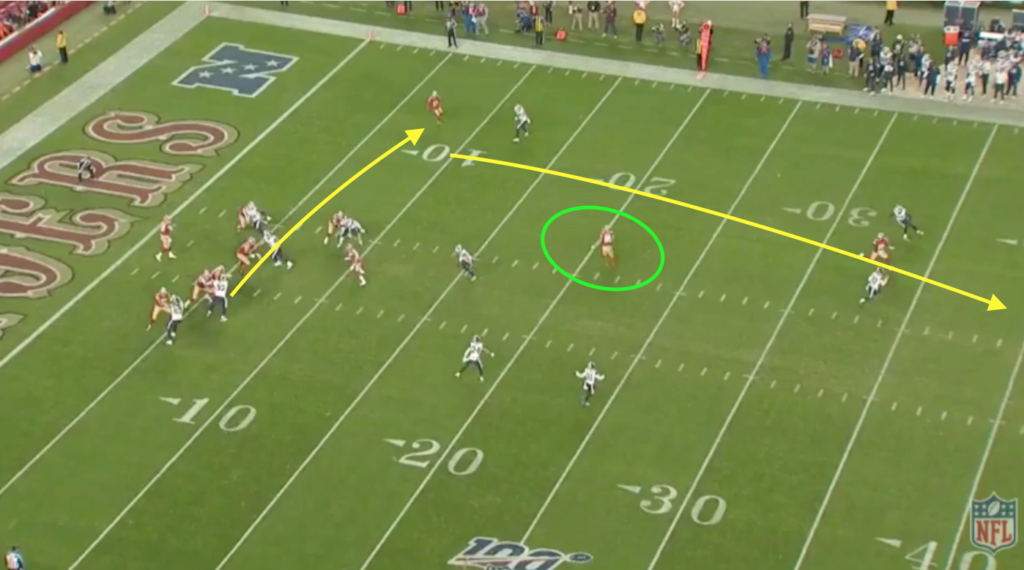
If you draw an imaginary line right through the defence, you can see how the three receivers running routes on the same side of the field are breaching it at three different levels. Shanahan has purposely used his receivers in tandem to pull the coverage apart. George Kittle is wide open because Deebo Samuel ran vertically and Emmanuel Sanders ran behind the line of scrimmage.
Kittle is wide open so Garoppolo has an easy throw to make. That's the foundation of the 49ers offence. It's harder for Garoppolo to fail than succeed in that situation.
For as long as he's been running NFL offences, Shanahan has required his receivers to have speed. Speed allows you to pull the coverage apart and create easy throws for the quarterback. Mike Mularkey never valued speed in his receivers, Arthur Smith doesn't appear to be making it a priority either. As such, the Titans have a group of skill position players who don't create wide windows to throw into.
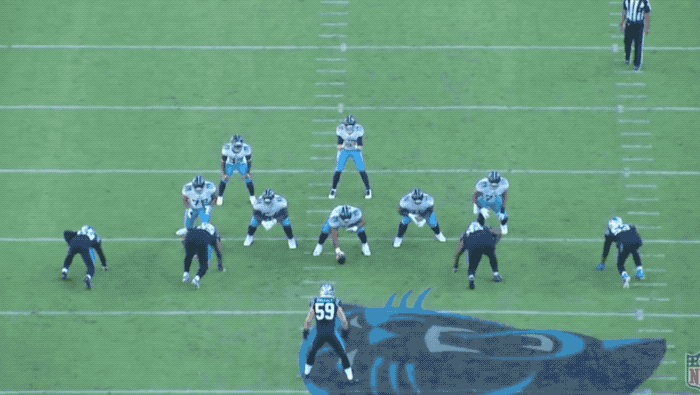
AJ Brown was Tannehill's best receiver last season. He is a tough, precise route runner who can create big gains after the catch. But he lacks high-end speed and while he's listed at 6'1", he doesn't have a huge catch radius like an A.J. Green or Mike Evans. As such, Brown regularly relied on Tannehill to fit the ball into small windows for him to make a play.
This throw against the Carolina Panthers comes on Third-and-7. Brown gets on the outside shoulder of the defender but can't create any separation downfield. Tannehill responds by dropping the ball perfectly over his outside shoulder. Anything less than a perfectly-placed pass falls incomplete here.
Furthermore, while Tannehill was making these throws, Brown dropped four accurate passes. Three of those travelled at least 10 yards past the line of scrimmage.
Drops have been a major problem for the Titans receivers for a long time now. Marcus Mariota was throwing to the worst receiving corps in the league for most of his years starting. Tannehill's receivers dropped 6.4% of his passes last season, the third-highest rate in the league. Tannehill overcame those drops by being phenomenally accurate in every situation, but again that's not sustainable over a large sample.
Run-oriented offences are supposed to keep the passing game ahead of the down-and-distance. Yet, Tannehill threw 44.2% of his passes from behind the down-and-distance last year. Only seven quarterbacks threw from behind the down-and-distance more often. Four of the seven were within 0.6% and Tom Brady led the league at 46.5%.
Derrick Henry didn't make Tannehill's role easier. He likely made it more difficult.
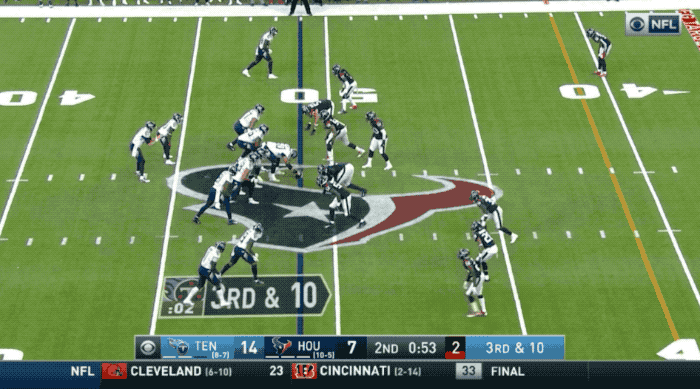
On Third-and-5+ last season (behind the down-and-distance), Tannehill threw to the first down line 56.2% of the time. That made him the 10th-most aggressive decision-maker on third downs in the NFL last year. He was 56.1% accurate on those throws, the 12th-best rate in the league. When quarterbacks play more behind the down-and-distance, they are at the mercy of the defence more often.
Being behind the down-and-distance means the running game is less of a factor. Play action isn't as impactful and the defence can abandon gaps in the running game to execute complex blitzes. It forces the quarterback to think and act quicker while making him more likely to throw an interception or take a sack.
Even quarterbacks who thrive in those scenarios can't do it often enough to keep pace with their counterparts in better offences. Mariota was the best quarterback in those scenarios during the 2018 season.
Tannehill elevated everyone in Tennessee last season. He covered for an offence that lacked dynamism and explosiveness. He re-established himself as one of the better quarterbacks int he NFL and he's worth more than the contract he was given this offseason. But that doesn't mean the Titans' success as a team with him from last season is sustainable.
Mike Vrabel's team overachieved. They don't have enough playmakers on either side of the ball to truly contend with the Baltimore Ravens and Kansas City Chiefs.
If Tannehill swapped places with Lamar Jackson or Patrick Mahomes, the Titans would beat both the Chiefs and the Ravens. That doesn't mean he's as good as those quarterbacks, it does mean the difference between them is smaller than the gap between each quarterback's supporting cast. The Dolphins blamed Tannehill for the failings around him for years. If the Titans regress next season, Tannehill will be the first in line for blame.
He might be the problem, it's more likely that the team as a whole peaked thanks to him in 2019.
Read more quarterback breakdowns on Off The Ball:
Aaron Rodgers is still an elite quarterback.
Baker Mayfield will be a liability again in 2020.
Download the brand new OffTheBall App in the Play Store & App Store right now! We've got you covered!
Subscribe to OffTheBall's YouTube channel for more videos, like us on Facebook or follow us on Twitter for the latest sporting news and content.

